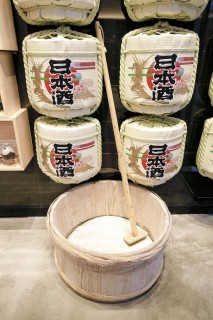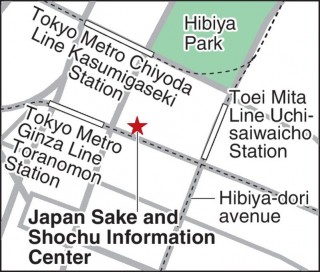Loading
Search
▼ Let’s Go To The Museum / Sake Center Showcases Flavors of Japan
- Category:Tourism
In a Tokyo district full of government offices, where bureaucrats and company employees in suits passed busily to and fro, I spotted a sugidama ornament hanging at the entrance of a building. This object, also called a sakabayashi, is a spherical bundle of cedar twigs that symbolically announces that a new batch of sake is ready.
Inside the building, I found many sake bottles and barrels displayed along the wall and a large tub made of natural cedar suspended from the ceiling. There were some customers with glasses of sake at small tables and a counter.
This is an information hub where visitors can learn everything about sake, operated by the Japan Sake and Shochu Makers Association. This summer, it was relocated from another building a few dozen meters away, and redesigned on the concept of enabling visitors to see, feel and experience the nature of sake.
About 50 brands of various types of Japanese alcoholic beverages — sake, shochu and awamori — are always available, chosen from the products of 1,754 member breweries and distilleries nationwide. Just seeing a variety of labels on bottles is interesting. In addition, visitors can taste sake and buy their favorites.
Tokkuri sake bottles and ochoko small cups, which are made by using traditional methods representing various parts of Japan, are also exhibited. Visitors can hold a real kaibo mixing stick that is used for stirring seed mash — cultivated yeast with steamed rice, water and koji mold. A large screen shows a movie about the process of sake making.
Partly because washoku, or traditional Japanese cuisine, was added to UNESCO’s Intangible Cultural Heritage list in 2013, sake has become more popular abroad. According to the Finance Ministry’s trade statistics, the volume of sake exports in 2015 reached 18,180 kiloliters, about double its volume in 2005.
Tokkuri sake bottles and ochoko small cups, which are made by using traditional methods representing various parts of Japan, are also exhibited. Visitors can hold a real kaibo mixing stick that is used for stirring seed mash — cultivated yeast with steamed rice, water and koji mold. A large screen shows a movie about the process of sake making.
Partly because washoku, or traditional Japanese cuisine, was added to UNESCO’s Intangible Cultural Heritage list in 2013, sake has become more popular abroad. According to the Finance Ministry’s trade statistics, the volume of sake exports in 2015 reached 18,180 kiloliters, about double its volume in 2005.
There are usually two English-speaking staff members at the center. The list of sake available for tasting and purchase is written in English as well as Japanese. Visitors can use a tablet device to learn about sake-pouring techniques and dishes that go well with sake in four languages — Japanese, English, Chinese and Korean.
A 26-year-old tourist from Britain drank sake for the first time and said, “It’s sweet and fantastic.”
A 26-year-old tourist from Britain drank sake for the first time and said, “It’s sweet and fantastic.”
Shuso Imada, 56, director of the center, said: “One of our strong points is that visitors can drink sake while having a conversation with our staff, who have abundant knowledge about sake. We would like visitors to use the center as an opportunity to become familiar with sake.”
Japan Sake and Shochu Information Center
The brands displayed or for sale are changed every two to three weeks. Visitors who wish to taste sake can choose a portion of 30 millilters or 60 millilters, with the price of a sample depending on the brand. The center also is planning events such as a sake-tasting that offers local sake from each prefecture and a study meeting for foreign visitors.
Address: 1-6-15 Nishishinbashi, Minato Ward, Tokyo
The first floor of Nihon Shuzo Toranomon building
Opening hours: From 10 a.m. to 6 p.m. Closed on Saturdays, Sundays and national holidays.
Admission: Free.
Phone: (03) 3519-2091
The first floor of Nihon Shuzo Toranomon building
Opening hours: From 10 a.m. to 6 p.m. Closed on Saturdays, Sundays and national holidays.
Admission: Free.
Phone: (03) 3519-2091
- October 21, 2016
- Comment (0)
- Trackback(0)





